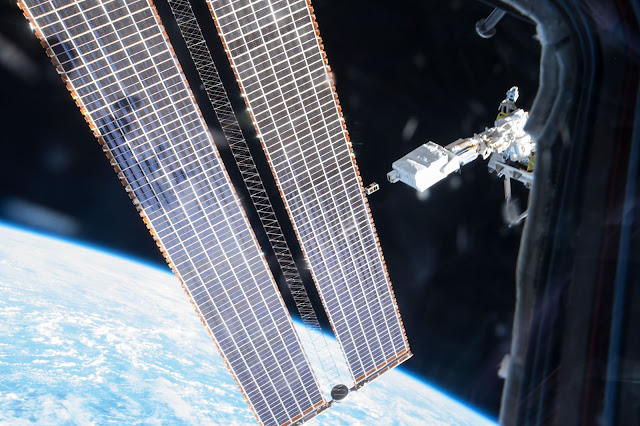ISS - Expedition 50 Mission patch.
Dec. 30, 2016
(Highlights: Week of Dec. 19, 2016) - There is new mood lighting installed in parts of the International Space Station to help improve the health of crew members.
NASA engineers are testing a new light design to replace the fragile fluorescent lights currently used in orbit. The new light-emitting diodes are the focus of the Testing Solid State Lighting Countermeasures to Improve Circadian Adaptation, Sleep, and Performance During High Fidelity Analog and Flight Studies for the International Space Station (Lighting Effects) investigation. NASA astronaut Peggy Whitson completed measurements of various light settings in multiple locations to ensure the LEDs provide enough light to be able to complete science experiments while improving her own cognitive performance. These LEDs are adjustable for intensity and color – the blue, white, or yellow sections of the light spectrum -- to determine if the new lights can improve crew sleep cycles and alertness during the day. Besides the potential health benefits, these lights also require less energy to run and are lower in mass, making them a prime candidate for use on future spacecraft. Using these lights and subtly adjusting their color temperature during the day may help people be more productive on Earth, especially people who work a night shift.
Image above: A satellite is ejected from the JAXA Small Satellite Orbital Deployer on the International Space Station. The satellite is actually two small satellites that, once at a safe distance from the station, separated from each other, but were still connected by a 100-meter-long Kevlar tether. Image Credit: NASA.
Whitson exchanged modules to prepare for another round of the Advanced Colloids Experiment-Temperature Control (ACE-T-1) study. For decades, astronauts and scientists have studied complex structures with unique properties in space. The station's microgravity environment allows for the study of microscopic structures in three dimensions without the potentially distorting properties of gravity. The ACE-T-1 investigation examines tiny suspended particles designed by scientists to connect themselves in a specific way to form organized structures in water. The investigation will help scientists understand how to control, change, and even reverse interactions between tiny particles, which helps in the development of self-assembling and replicating technologies on Earth.
NASA astronaut Shane Kimbrough installed new sample cartridges for further materials research in the JAXA (Japan Aerospace Exploration Agency) Electrostatic Levitation Furnace (ELF). The device is an experimental facility that melts and solidifies materials while levitating them to test a containerless processing technique. With this facility, thermo-physical properties of high-temperature melts can be measured and solidification from deeply undercooled melts can be achieved.
Image above: New LED lights are tested on Earth before being launched to the International Space Station. The lights will replace the fragile bulbs currently on station, will use less energy and are adjustable light sources, which could help improve the sleep cycle and cognitive performance of crew members. Image Credit: NASA.
Scientists want to levitate these materials so they won't introduce potential contaminants or impurities from a container holding the material as it changes from a solid to a liquid and back again. The ELF uses an electrostatic force to help levitate the material, and lasers of varying strengths to heat the material. Data from the investigation may help develop advanced materials for new technology and devices on Earth and in space.
Whitson helped the JAXA ground team to deploy the Space Tethered Autonomous Robotic Satellite (STARS-C) using the JAXA Small Satellite Orbital Deployer (J-SSOD). The satellite is actually two identical satellites connected by a 100-meter-long Kevlar tether. Once deployed, the satellites will point toward Earth and use a spring system and gravitational forces to separate, pushing one satellite closer to the planet. Besides being a technology demonstration, the investigation will also collect electrons from the plasma environment in space to analyze the creation of an electrical current.
The satellite deployment capability provides a unique satellite launching system for use on the station. Handled by the robotic arm known as the Japanese Experiment Module Remote Manipulator System (JEMRMS), the system provides a reliable, safe and economically viable means of deploying small research satellites into orbit. Crew members load pre-packed satellites into J-SSOD on a special sliding table in the Japanese Experiment Module (JEM) airlock to transfer the payload to the space environment where the robotic arm will grapple it and maneuver into position for deployment. After the successful STARS-C deployment, ESA (European Space Agency) astronaut Thomas Pesquet recovered the J-SSOD and installed another set of satellites scheduled for deployment next week.
ISS - International Space Station. Animation Credit: NASA
Progress was made on other investigations and facilities this week, including Veg-03, ISS Ham, Story Time From Space, ACE-T-1, Group Combustion, Packed Bed Reactor Experiment (PBRE), Aerosol Samplers, Manufacturing Device, Personal CO2 Monitors, PS-TEPC, Combustion Integrated Rack, and Fluids Integrated Rack.
Crew members conducted other human research investigations this week, including Biochem Profile, Repository, Habitability, Fine Motor Skills, Fluid Shifts, Sarcolab, Dose Tracker and Space Headaches.
Related links:
Performance During High Fidelity Analog and Flight Studies for the International Space Station (Lighting Effects): https://www.nasa.gov/mission_pages/station/research/experiments/2279.html
Advanced Colloids Experiment-Temperature Control (ACE-T-1) study: http://www.nasa.gov/mission_pages/station/research/experiments/2033.html
Electrostatic Levitation Furnace (ELF): http://iss.jaxa.jp/en/kiboexp/pm/elf/
Space Tethered Autonomous Robotic Satellite (STARS-C): http://nssdc.gsfc.nasa.gov/nmc/spacecraftDisplay.do?id=2014-009H
JAXA Small Satellite Orbital Deployer (J-SSOD): http://www.nasa.gov/mission_pages/station/research/experiments/J-SSOD.html
Japanese Experiment Module Remote Manipulator System (JEMRMS): http://iss.jaxa.jp/en/kibo/about/kibo/rms/
Japanese Experiment Module (JEM): https://www.nasa.gov/mission_pages/station/structure/elements/jem.html
Japan Aerospace Exploration Agency (JAXA): http://global.jaxa.jp/
Veg-03: https://www.nasa.gov/mission_pages/station/research/experiments/1294.html
ISS Ham: http://www.nasa.gov/mission_pages/station/research/experiments/346.html
Story Time From Space: https://www.nasa.gov/mission_pages/station/research/experiments/1287.html
ACE-T-1: https://www.nasa.gov/mission_pages/station/research/experiments/2033.html
Group Combustion: https://www.nasa.gov/mission_pages/station/research/experiments/1077.html
Packed Bed Reactor Experiment (PBRE): https://www.nasa.gov/mission_pages/station/research/experiments/1111.html
Aerosol Samplers: https://www.nasa.gov/mission_pages/station/research/experiments/2300.html
Manufacturing Device: https://www.nasa.gov/mission_pages/station/research/experiments/2198.html
Personal CO2 Monitors: http://www.nasa.gov/mission_pages/station/research/experiments/2101.html
PS-TEPC: https://www.nasa.gov/mission_pages/station/research/experiments/1079.html
Combustion Integrated Rack: https://spaceflightsystems.grc.nasa.gov/sopo/ihho/psrp/fcf/cir/
Fluids Integrated Rack: https://spaceflightsystems.grc.nasa.gov/sopo/ihho/psrp/fcf/fir/
Biochem Profile: http://www.nasa.gov/mission_pages/station/research/experiments/1008.html
Repository: https://www.nasa.gov/mission_pages/station/research/experiments/981.html
Habitability: https://www.nasa.gov/mission_pages/station/research/experiments/1772.html
Fine Motor Skills: https://www.nasa.gov/mission_pages/station/research/experiments/1767.html
Fluid Shifts: https://www.nasa.gov/mission_pages/station/research/experiments/1257.html
Sarcolab: https://www.nasa.gov/mission_pages/station/research/experiments/738.html
Dose Tracker: http://www.nasa.gov/mission_pages/station/research/experiments/1933.html
Space Headaches: http://www.nasa.gov/mission_pages/station/research/experiments/181.html
Space Station Research and Technology: https://www.nasa.gov/mission_pages/station/research/index.html
International Space Station (ISS): https://www.nasa.gov/mission_pages/station/main/index.html
Images (mentioned), Animation (mentioned), Text, Credits: NASA/John Love, Acting Lead Increment Scientist, Expeditions 49 & 50/Kristine Rainey.
Best regards, Orbiter.ch




